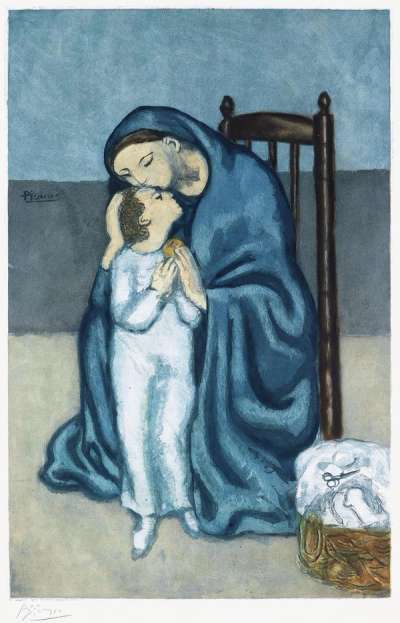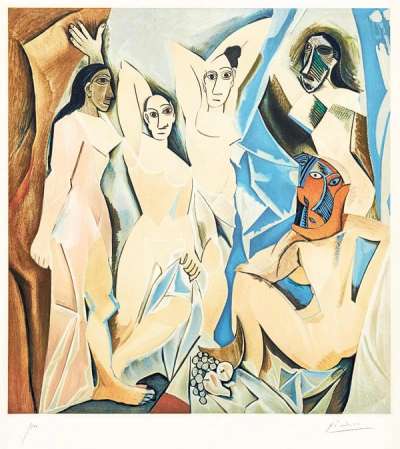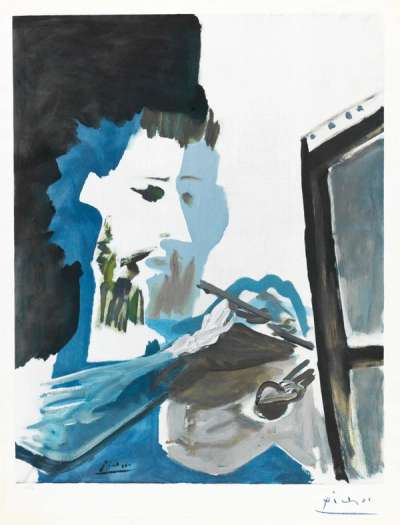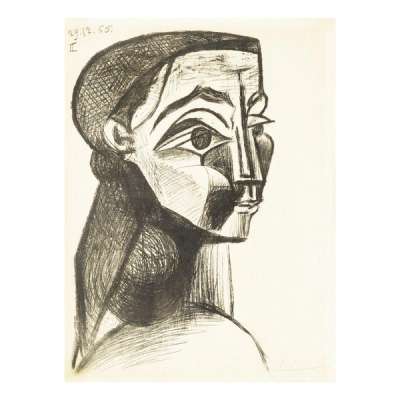Picasso’s Blue Period

 Image © Musée national Picasso-Paris / Autoportrait © Pablo Picasso 1901
Image © Musée national Picasso-Paris / Autoportrait © Pablo Picasso 1901
Pablo Picasso
137 works
Born in 1881 in Málaga, Spain, Pablo Picasso's journey began early, leading to his role as a co-founder of Cubism and a pioneer of Modernism. Yet, his Blue Period (1901-1904) stands as a distinct chapter, born from the tragedy of his friend Carlos Casagemas' death. Reflecting the era's societal woes, its sombre palette and melancholic themes demonstrate Picasso's mastery in capturing life's raw, unavoidable truths. This period marked a significant shift towards expressionism in modern art and set the stage for his subsequent innovations. Ultimately, Picasso’s Blue Period reveals how personal grief in art can be channelled into compelling compositions.
 Image © National Museum of Picasso-Paris / La Mort De Casagemas © Pablo Picasso 1901
Image © National Museum of Picasso-Paris / La Mort De Casagemas © Pablo Picasso 1901The Genesis of Picasso's Blue Period
Picasso’s Blue Period, a transformative phase in his artistic journey, was deeply influenced by both personal tragedy and the socio-economic climate of early 20th century Spain and Paris. The 1901 suicide of his close friend Carlos Casagemas marked a turning point, immersing Picasso in a state of deep melancholy. This emotional state, coupled with his encounters with poverty and social marginalisation, steered his artistic focus.
Marked by empathetic depictions of the downtrodden, the Blue Period is noted for its monochromatic blue palette, symbolising themes of melancholy, solitude, and despair. During these years, Picasso’s art evolved into a profound exploration of life's darker aspects, offering a reflective commentary on suffering and isolation.
The Significance of Blue in Picasso's Blue Period
In Picasso's Blue Period, the colour blue transcends its traditional palette role, becoming a profound symbol of emotion, mood, and meaning. This era marks a radical departure from the warm hues of his earlier works, embracing blue in its myriad shades to paint a spectrum of emotions that range from deep melancholy to transient serenity. In Western art, blue has historically symbolised depth, stability, trust, wisdom, and intelligence. Picasso, however, subverts these connotations, employing blue to articulate sorrow, isolation, and existential angst. His innovative use of this colour does more than portray his subjects' emotional states; it envelops the viewer in an atmosphere of introspective melancholy.
Emerging from an accidental alchemical reaction in 18th-century Berlin, Prussian blue was the hue that helped revolutionise Picasso’s palette. Dye-maker Johann Jacob Diesbach initially tried to concoct a red pigment, but fortunately his mix of potash and animal blood resulted in a deep, soulful blue hue. Prior to being created, other shades of blue didn’t hold up well for actual painting, as blues sourced from indigo were likely to fade. Prussian blue allowed for more stability in compositions resulting in its use in many of art history's most memorable works; however it is perhaps most recognisable for its role in Picasso's Blue Period, defining the era's visual landscape.
The Masterpieces of Picasso's Blue Period
La Vie
La Vie, one of Picasso's most enigmatic and celebrated creations, is often regarded as a canvas rich in allegory, encompassing themes from the cycle of life and death to the intricacies of human relationships and artistic struggle. The painting features a nude couple and a woman holding a baby, set against a backdrop of other figures engulfed in emotional turmoil. Its composition, marked by rigid gestures and a compressed spatial arrangement, is bathed in the characteristic blues of Picasso's Blue Period. Initially conceived as a self-portrait, the male figure on the left morphed into the likeness of Casagemas, Picasso's deceased friend, hinting at the deeply personal connection Picasso had with the work.
The faces of Picasso’s subjects are dressed in despair while their gazes engage in a silent dialogue preoccupied with the existential dilemmas of life. This artwork travels into the darker corridors of the psyche, particularly through its layered composition that includes a painting within the painting. This narrative element suggests an exploration of the impact of our environments on our inner lives. By mirroring the surroundings of the individuals in the artwork itself, Picasso may be subtly conveying a nuanced commentary on how our contexts shape our perceptions, emotions, and identities, offering a multi-dimensional view of our own experiences.
 Image © Art Institute Chicago / The Old Guitarist © Pablo Picasso 1903
Image © Art Institute Chicago / The Old Guitarist © Pablo Picasso 1903The Old Guitarist
The Old Guitarist captures the essence of an aged, visually impaired musician, with his form bent over his guitar. The use of a limited, predominantly blue colour palette in this painting heightens the sense of desolation and grief, eliciting a powerful response from its viewers.
In The Old Guitarist, there is an unmistakable parallel between the musician's plight and the artist's own existential fears. The image of the man, reliant on his guitar for sustenance, resonates with Picasso's early struggles as an artist, where the inability to sell his work would directly impact his means of living. This reflection provides the painting with an added layer of empathy, as Picasso sees a part of himself in the guitarist's struggle. The musician's reliance on his art for survival echoes Picasso's own journey, highlighting the precarious nature of artistic life. This connection lends the artwork additional meaning emphasising not just the struggle depicted within the frame, but also the broader challenges faced by artists in society.
Picasso's Transition from the Blue Period
Picasso's artistic evolution from the Blue Period to the Rose Period, and ultimately towards Cubism, is a fascinating journey of chromatic and thematic transformation. As the Blue Period's quieter tones and introspective themes faded around 1904, the Rose Period emerged, characterised by its warm hues of pink and orange, reflecting a more optimistic phase in Picasso's life. This period, marked by lighter, joyous scenes often featuring circus performers and harlequins, signified a transition in Picasso's emotional and artistic state.
However, this shift was not just a change in colour but a prelude to a more radical artistic revolution: the advent of Cubism. Picasso's journey through the Rose Period acted as a bridge, guiding him away from traditional representation towards the fragmented, abstract forms of Cubism. This progression underscores Picasso's restless innovation and his profound influence on the course of 20th-century art, marking a pivotal moment in the narrative of modern art.
 "Le Repas De L’aveugle" by Pablo Picasso. Licensed under CC BY 2.0. (Link:https://www.flickr.com/photos/suburbanslice/4060963178)
"Le Repas De L’aveugle" by Pablo Picasso. Licensed under CC BY 2.0. (Link:https://www.flickr.com/photos/suburbanslice/4060963178)The Impact of Picasso's Blue Period on Modern Art
Thematic Transitions
During the Blue Period, Picasso broke away from the traditional confines of art, both in subject matter and style. He chose themes that were starkly real and emotionally charged, focusing on the plight of the impoverished, the sick, and the socially marginalised. This shift towards a more empathetic portrayal of human suffering was a significant departure from the predominant themes of beauty and idealism in art at the time. This change not only revolutionised Picasso's own artistic narrative but also influenced the trajectory of modern art.
Social Commentary
Specific pieces from this period, like The Old Guitarist and La Vie, became icons of this new artistic sensibility. The Old Guitarist, with its emaciated, blind musician, is a compelling study of isolation and despair. Similarly, La Vie examines complex themes of existence and human relationships. Picasso’s depiction of societal outcasts: beggars, prostitutes, and the impoverished, became his vehicle for social commentary of his time. These works, with their haunting blue tones and expressive figures, challenged traditional aesthetics and ushered in a more introspective and psychologically nuanced approach to art.
 Image © Cleveland Museum of Art / La Vie © Pablo Picasso 1903
Image © Cleveland Museum of Art / La Vie © Pablo Picasso 1903Inspiring Figurative Art
Francis Bacon's art bears a clear imprint of Picasso's exploration of human vulnerability and distorted figures. In Bacon's raw, emotionally charged canvases, one can discern a direct lineage from the angst and isolation that permeated Picasso's Blue Period. Bacon’s work, much like Picasso’s, examines the complexities of the human psyche, often portraying a grim reality through a multidimensional approach to visual narratives. His canvases, filled with distorted figures and unsettling atmospheres, reflect a similar engagement with themes of suffering and existential despair. In this way, Bacon’s art can be seen as a continuation of the introspective journey that Picasso began, explored through Bacon’s perfect marriage of melancholy and macabre.
 Image © Hermitage Museum of Saint-Petersbourg / L’Entrevue © Pablo Picasso 1902
Image © Hermitage Museum of Saint-Petersbourg / L’Entrevue © Pablo Picasso 1902The Legacy of Picasso's Blue Period
This seminal period, renowned for its introspective portrayal has become a wellspring of inspiration in literature, cinema, and music. Artists in these fields frequently draw upon the Blue Period's exploration of psychological depth, using it as a canvas to paint their interpretations of the complexities inherent in the human psyche.
In the broader cultural sphere, the Blue Period serves as a poignant reference in discussions surrounding mental health and artistic expression. It underscores the intricate relationship between creative genius and emotional struggle, providing a nuanced perspective on the therapeutic potential of art. The themes of sorrow and isolation that dominate this period resonate with contemporary audiences, offering a timeless reflection on the universal aspects of human experience.
Displayed in esteemed museums and galleries worldwide, these pieces are not just historical artefacts but living testaments to the relevance of Picasso's vision. Their presence in modern spaces invites a continuous dialogue between past and present, encouraging new generations to engage with and reinterpret the legacy of this transformative era in art history.














